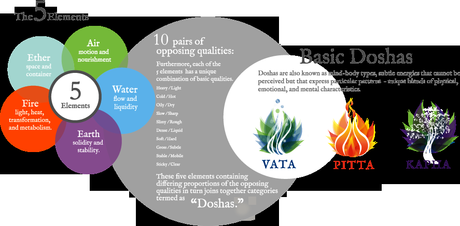Ayurveda is ancient system of medicine in the world. It is originated in India about 5000 years ago. The word Ayurveda means "science of life" and it is derived from two Sanskrit words (life) and (science or knowledge).

This shloka is from Charak Samhita and its meaning is Ayurveda is a science that describes the advantages, disadvantages, happy and unhappy state of life and what is good or bad for life and its span. It is an ancient science which deals with not only longevity but also maintaining healthy body and mind. It is a science of body and mind

MULBHOOT SIDDHANTA (Basic Principles of Ayurveda)
Ayurveda lies on two basic principles which are explained below:
- Dosha-Dhatu-Mala Siddhanta
- Panchamahabhoot Siddhant
Dosha-Dhatu-Mala Siddhanta
"Doshadhatumalamulam hi shariram"This siddhanta explains the basic constitution ofhuman beings- three doshas, seven dhatus and three malas.
- Tridoshas- These are also called tri-energies. There are three main doshas in the body which are Vata, Pitta and Kapha. Balance of all three doshas make body healthy and normal and imbalanced state is considered as diseased state. Ayurvedic treatment mainly lies on the balance of all three doshas.
- Sapta Dhatu- It explains the body consists of seven dhatus which are given below:
- Rasa (Plasma) - Its main function is Prinan (to provide nourishment to body).
- Rakta (Blood) - It is considered very important for sustaining life.
- Mamsa (Muscle) - It covers all the internal body components and performs function of Lepan.
- Meda (Fat tissue)- Its main role is Snehan means oleation in different body parts like lubrication to joints and it also provide extra safety to tissues.
- Asthi (Bones) - It provides support to body (Dharan).
- Majja (Bone Marrow) - It is located in the hollow cavity of bones and it helps to provide extra support.
- Shukra (Semen) - Its main function is in reproduction.
- Mala- There are three malas in body- Purish (faeces), Mutra (Urine) and Sweda (sweat).

Panchamahabhoot Siddhant
It explains that human body is composed of five basic elements ( Panchamahabhoot) namely- Prithvi (earth), Jal (water), Tej (fire), Vayu (air) and Akaash (ether). It is said that:
It means that if these elements are in equilibrium then body is healthy and functions smoothly. And its imbalance causes illness.
- It is a Sanskrit version in ayurvedic text which explains health:
- Samdosha meaning balanced doshas- vata, pitta and kapha
- Samaagnishcha means balanced agni or digestive or metabolic fire.
- Samadhatu meaning dhatus or tissues are well nourished.
- Malakriya meaning balance in excretion or waste disposal through urine, stool and sweat.
- Prasanna atma means peaceful soul.
- Prasanna indriya means balanced senses.
- Prasanna manah means happy state of mind.
- If all these are balanced then a person is called healthy. Any deviation or disruption or any Imbalance of these is called a disease.
How Ayurveda works?
According to Ayurveda, all creations are made up of five elements: ether, air, water, earth and fire. These are basic aspects of human life. On the basis of these elements Ayurveda works. When these elements are balanced and strong then person works in a healthy way. Imbalance of any three doshas results in disease. Panchkarma Therapy (Sanshodhan): It is useful to remove extra toxins from body by bio-purificatory methods.
Pacification (Shaman): It works through diet, lifestyle changes, herbs etc.
ANCIENT TEXTS OF AYURVEDA
There are two main classifications of Ayurvedic Texts:
It is comprised of three treatises- Charak Samhita, Sushrut Samhita and Ashtang Haridya.
- Charak Samhita: It is the oldest Ayurveda text which is written by Acharya Charak. He is regarded as father of medicine. He explain eight branches of Ayurveda and Panchkarama.
- Sushrut Samita: It is written by Acharya Sushrut. He is the father of surgery. He explained the human anatomy and various surgeries. He followed Dhanwantri School of thought.
- Ashtang Haridaya: It is combination of Charak and Sushrut Samhita. It is written by Acharya Vagbhata.
It is comprised of three treatises- Madhav Nidan, Sharangdhar Samhita and Bhava Prakash Samhita.
- Madhav Nidan: It is an ayurvedic text written by Acharya Madhav. It mainly works on pathogenesis of disease (Roga Vinishchaya) like causes, symptoms, complications and treatment.
- Sharangdhar Samhita: It is written by Acharya Sharandhara. It includes information of different formulations. It describes general description of health, and pulse diagnosis.
- Bhava Prakash Samhita: It is written by Acharya Bhavmisra. It includes all information related to herbs, diseases and different formulation used in Ayurveda.
BRANCHES OF AYURVEDA:
The Ayurveda is an ancient medicine system which is divided into eight branches:
- Kaaya Chikitsa (Internal medicine)
- Kaumar Bhritya (Pediatrics treatment)
- Bhoot Vidya (Psychiatry)
- Shalakya Tantra (treatment of eyes, nose, throat, head related disease)
- Shalya Tantra (Surgery)
- Agad Tantra (toxicology)
- Rasayana (Geriatrics)
- Vajjikarana (Aphrodisiac therapy)
- Kaaya Chikitsa: Kaaya means agni - the digestive fire in the body. It is holistic approach of medicine which is mainly helpful in treatment of whole body. It is related to metabolism in the body. If imbalance of kaaya occurs it results in many diseases. It deals with treatment of diseases by balancing agni.
- Baala Chikitsa: It is also called Kaumara Bhritya. It is the branch of Ayurveda which is concerned with treatment of children.
- Bhoot Vidya: It is the branch of ayurvedic science which deals with treatment of diseases of mind.
- Shalakya Tantra: It mainly deals with treatment of eyes, nose, throat and ears.
- Shalya Tantra: It deals with surgery.
- Agad Tantra: It includes the study of poisonous substances.
- Rasayan Chikitsa: It deals with various aspects of healthcare. Its main aim is to achieve long and healthy life, memory, complexion glow and strength
- Bajikaran Chikitsa: It deals with problems of shukra dhatu in the body.

